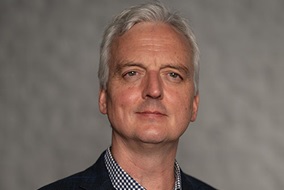Astonishing teamwork drove renal denervation at Medtronic
It all started 14 years ago with a whim, some extra cash, and a spectacular example of speed and decisiveness.
Our journey toward developing the Symplicity blood pressure procedure, a breakthrough approach that uses radio frequency energy to reduce hypertension, started 14 years ago with a whim, some extra cash, and a spectacular example of speed and decisiveness.
“It’s by far my favorite memory at Medtronic,” recalled Julie Trudel, Ph.D., who served as the senior program manager at the time and spearheaded our dive into renal denervation technology.
Right before the July 4 U.S. holiday in 2009, Julie’s boss – recently retired vice president of R&D Mark Gaterud – gathered his teams of engineers and shared good news.
“He said he had a million R&D dollars available, but we had to spend them quickly. He told us to come back after the holiday with ideas and he would consider them,” Julie remembered.
Julie huddled with her team and returned with a proposal: “Let’s do what Ardian is doing, only better.”
An all-star team
Earlier that year, a startup called Ardian published promising clinical results of its renal denervation device, which used radio frequency energy to disrupt nerves inside the kidneys and lower blood pressure.
“We felt we had the expertise within Medtronic to do the same thing, but also to improve on Ardian’s prototype,” Julie said.
Julie’s proposal won approval. What followed astonishes colleagues to this day.

Julie brought together experts from several operating units to evaluate any existing Medtronic technology that might replicate Ardian’s work. “We looked at ablation, cryo, and miniaturization – all kinds of things,” she said. “Individuals from all over the company were saying ‘yes, I have a product that might work.’ Or ‘yes, we can make this smaller.’ It was amazing.”
In just weeks, Julie’s team of engineering all-stars stood up a research lab. Early results were so promising that by the end of the year, they pulled together a new funding request.
And by early 2010, three teams were working full time, in parallel, on three different methods of performing renal denervation.
“If there was ever a point in time where everything seemed to be working toward a greater purpose, this was it for me,” she said.
“Julie and her team put our renal denervation research on booster rockets,” remembers Sean Salmon, EVP and president of our cardiovascular portfolio. “It was amazing. Unbelievable.”
Adding Ardian
Our internal renal denervation effort went so well that in fall of 2010, when we announced we were buying Ardian, Julie’s all-stars got permission to continue their own work.
Adding Ardian meant we had four simultaneous efforts underway to develop renal denervation, code-named Flex/G2, Tornado, Fuego, and SMERF.
While the technology acquired from Ardian was already under clinical investigations (Flex/G2), Julie led SMERF, short for Simultaneous Multi-Electrode Radio Frequency. SMERF developed a prototype that was ready for clinical study in humans in less than a year.
“Julie just had an incredible belief that her team could do what it did,” said Paul Coates, a distinguished engineer and also an important figure in our renal-denervation journey. “She drove a team that accomplished things in 18 months that no one within Medtronic believed possible.”
Following the research
As research determined what worked best and what didn’t, our focus narrowed to just SMERF, eventually resulting in Symplicity Spyral, which combined designs from Medtronic and the original Ardian to become our first device-based procedure to lower high blood pressure.
“It’s wonderful to know we developed something capable of helping so many people,” Julie said. “There are so many individuals who played important roles. I’m just grateful to have been part of it.”
Julie’s work isn’t done. She’s now leading next-generation research projects to help identify what physiological traits might make certain hypertension patients better-suited to receive renal denervation. It’s intricate, complicated, groundbreaking work – making Julie Trudel just the person for the job.
Important Safety Information
The Symplicity™ blood pressure procedure (BPP) is a minimally invasive procedure approved to help lower high blood pressure. The procedure is approved as a complement to treatments you may already be trying, such as lifestyle modifications and high blood pressure medications that might not be adequately controlling your blood pressure.
Receiving the Symplicity BPP should be a based on a joint decision between you and your doctor consider the benefits and risks of the device and procedure. Please talk to your doctor to decide whether or not the Symplicity BPP is right for you.
If you have a pacemaker or an ICD your doctor will follow-up with steps to take ahead of the procedure if you decide it is right for you.
At the time of your procedure, your doctor may detect certain anatomical conditions (e.g., your blood vessels are too big or too small) that do not allow the blood pressure procedure to continue.
You should not receive the procedure if you cannot tolerate medications that are required for the procedure, like atropine, nitroglycerin, systemic blood thinners, or certain pain medications. These medications are to help you in case your heart rate drops too low, you experience pain, or your blood vessels tighten during the procedure. You should not receive the procedure if you are pregnant.
The Symplicity BPP has not been studied in patients:
- Who are breastfeeding
- Who are under 18 years old
- Who have isolated systolic hypertension (only the “top number” of your blood pressure is high)
- Who have secondary causes of high blood pressure
- Who have had a renal stent placed less than 3 months prior to the procedure
- Who had a prior minimally invasive treatment in their renal arteries (stenting, angioplasty or prior renal denervation)
Potential Risks of the Symplicity BPP: (Note that you may experience other problems that have not been previously observed with this procedure)
- Allergic reaction to the imaging solution
- Damage to your arteries
- Future narrowing of your arteries
- Arterio-enteric fistula (an abnormal connection between your aorta and your gastrointestinal tract)
- AV fistula (an irregular connection between an artery and a vein)
- Bleeding or blood clots
- Bruising where the device enters your body (mild or severe)
- Cardiac arrest or Heart attack
- Death
- Deep vein thrombosis
- Swelling
- Slow heart rate
- Infection
- Low or high blood pressure
- Damage to your kidneys that may cause one or both to stop working
- Nausea or vomiting
- Peripheral ischemia (lack of blood supply to your limbs)
- Pulmonary embolism (a sudden block in your arteries that send blood to your lungs)
- Pseudoaneurysm (blood collecting on the outside of a vessel wall causing a balloon-like widening)
- Pain or discomfort
- Skin burns from the failure of the equipment during the procedure
- Exposure to radiation
- Stroke
For further information, please call and/or consult Medtronic at 707-525-0111 or Medtronic’s website at medtronic.com
L001-12012023
Related content



